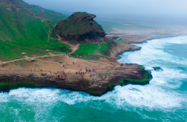Cruise ship passenger arrivals at Port Sultan Qaboos in Muscat are expected to reach a record 231,100 for the 2010/11 fiscal year ending in June – a year-on-year increase of 72%. The total number of cruise ship visits to the port is also forecast to increase to 94, up from 78 in 2009/10.
Oman has become an increasingly popular cruise destination over the past few years. Passenger arrivals have risen more than fivefold since 2007, when only 44,885 cruise ship visitors docked at Muscat.
“The results are very pleasing,” Salem Al Mamari, the director-general of tourism promotion at the Ministry of Tourism, told local press in April. “We are seeing some welcome recognition in Oman as a preferred cruise destination.”
Al Mamari emphasised that the Ministry of Tourism must pursue an intensive marketing plan to build global awareness of Oman’s appeal as a destination, a strategy he hopes will bring more than 300,000 cruise passengers a year to Port Sultan Qaboos by 2015.
Given the Sultanate’s potential for becoming a major cruise destination, the Ministry of Tourism is seeking to attract more vessels to Omani ports. Local press reported in March that plans are also under way to base an eco-friendly cruise ship out of an Omani port.
The continued expansion of Oman Air, which now serves 24 countries, will help in making this growth possible, according to the ministry. The airline added eight new destinations in 2010, two of which are served by Airbus A330 aircraft, according to Peter Hill, the airline’s CEO. Statistics from the International Air Transport Association reported a record 2.08m arrivals to Muscat International Airport in 2010 – a 13% increase over 2009 figures.
The proportion of transit and point-to-point travellers is expected to change over the coming years, as tourism in the country increases. “In the future we should see more point-to-point travellers passing through the Muscat International Airport, as Oman becomes more popular,” Hill told OBG.
Several major cruise operators have added Omani ports to their tours, recognising the increasing appeal of the Sultanate’s rich history and archaeological sites.
“More cruise companies are including Muscat in world itineraries, as well Salalah and Khasab as distinctive regional destinations in their own right,” Al Mamari said. “The other welcome trend is the decision by a number of companies to deploy their larger vessels to our region.”
The Italian firm Costa Cruises, which is the largest cruise company in Europe, sent its ship the Luminosa, with more than 2900 passengers, to Muscat and Salalah in March as part of a world tour. Stops at both ports are lined up as part of Costa’s regional itineraries for 2011 and 2012. The company offers several options for shore excursions at both ports, including a tour of the souk in Muscat; a trip from Muscat to visit Jabrin Castle near Nizwa; and a trip from Salalah to Jebel Qara to visit the tomb of the prophet Job.
The British-American luxury cruise firm Cunard’s Queen Elizabeth, a 294-metre-long liner with a capacity of 2068 guests, paid its first visit to Muscat in early April – a particularly significant call to port as it was part of the ship’s first world tour since its launch in October 2010. Another of Cunard’s ships, the Queen Mary 2, made its first visit to Salalah in May 2009 and docked in Muscat in January 2010. Port Sultan Qaboos is now a regular stop on the operator’s world cruise itineraries.
Joining Costa and Cunard is Miami-based Royal Caribbean International, which recently announced the extension of its 2011/12 Middle Eastern cruise programme – its third active season in the region. The itinerary of Brilliance of the Seas will include 18 round-trip seven-night cruises leaving from Dubai and stopping in Fujairah, Abu Dhabi and Muscat. Port Sultan Qaboos is also a stop in the company’s new 12-night Dubai-to-India itinerary.
Oman’s appeal as a day-trip location also seems to be on the rise. Many UAE-based companies are now offering day-long trips from Dubai to the northern governorate of Musandam. These tour companies offer cruises through the area’s fjords on a traditional Omani dhow, including meals and the opportunity to snorkel and swim over the course of the day.
Yachting is also a growing niche area for tourism, especially along the southern coast, including Salalah, which gets significant yachting traffic as part of Red Sea cruises. Meanwhile, the government, which owns all marinas, is growing the sector in and around Muscat, where more marinas are being planned. Once there are enough marinas for yachts to sail between, the number of sailors visiting the region is likely to increase, according to Bob Locker, the marina manager at Marina Bandar in Muscat.
“Tourism has great future in Oman. Its nature is beautiful, its people friendly and open, and its heritage vast and unique,” Locker told OBG.
With increased air links and calls to port, the tourism sector – both along the coast and further inland – stands to benefit, along with the wider economy.

